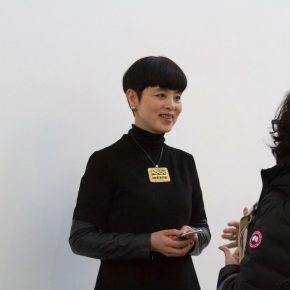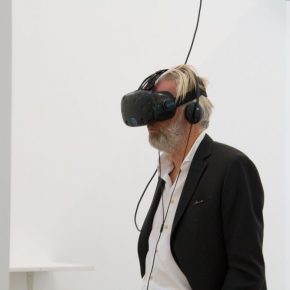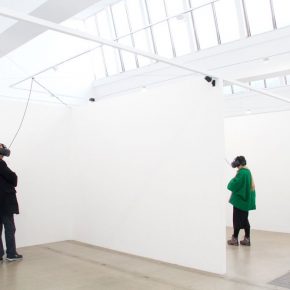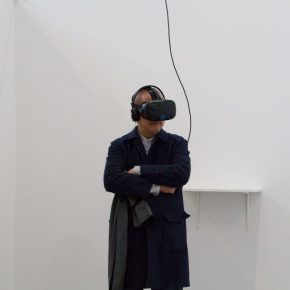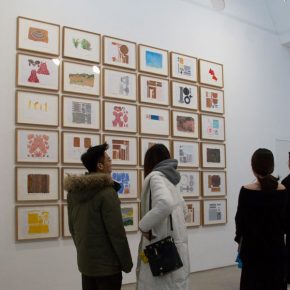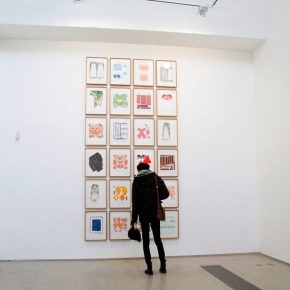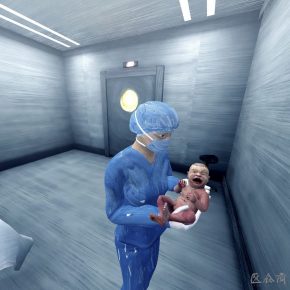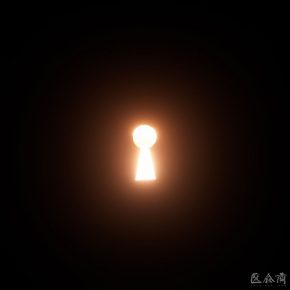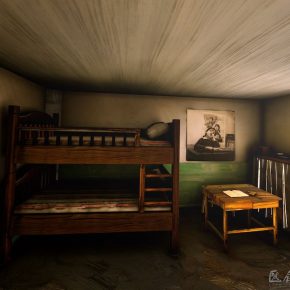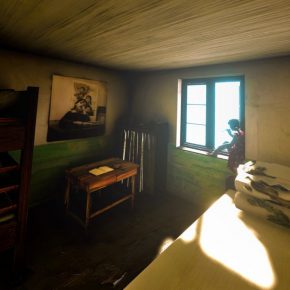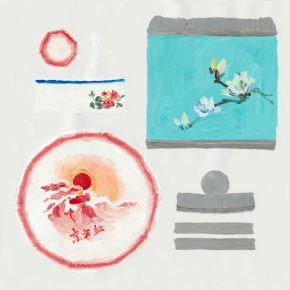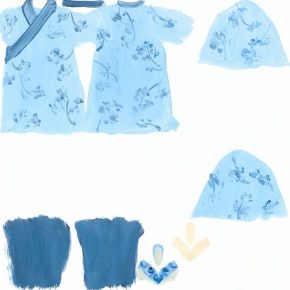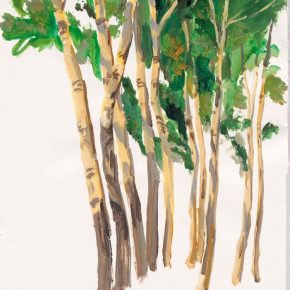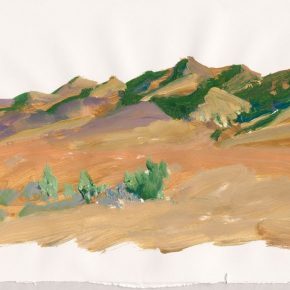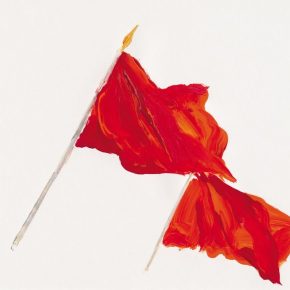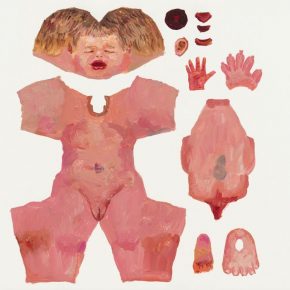
Which new sparks will fly when traditional oil painting encounters contemporary science & technology? Which wonderful experiences will be constructed by the combination of unique brushwork and fashion via Virtual Reality? On January 7, 2018, a famous female artist Yu Hong’s new Virtual Reality artwork “She’s Already Gone”, which is the fifth and final Virtual Reality artwork of Faurschou Foundation, was premiered at Faurschou Foundation, Beijing. In the “She’s Already Gone”, the spectator is invited to follow the life of a female character from birth to old age. As the character’s life moves forward, the viewer will notice that history itself moves backwards slowly in a dynamic scene that is different from two-dimensional painting. It is the first time for Yu Hong to blend the distinctive style of painting with the Virtual Reality of Khora Contemporary and the art of oil painting has gained fresh vitality in the fusion of a new medium.
From Two-Dimensional to Multi-Dimensional: the New Challenge of Virtual RealityVirtual Reality has successfully entered the global market at a ground-breaking and unusual rate. In the ancient art world which has kept pace with the times, this medium has gradually become a strong support for the energetic artists to explore cross-border exploration and broaden the language of art. In the fusion and collision between traditional techniques and new technologies, the relationship between the artist and viewer has been reconstructed, with many opportunities and possibilities.
As one of the most important artists in China, Yu Hong’s works are known for her traditional two-dimensional paintings based on oil paintings. Throughout her artistic background – In the 1980s, she studied oil painting at the Central Academy of Fine Arts (abbr. CAFA) in Beijing, and studied at the Department of Oil Painting in 1996 where she gained a master’s degree. Since 1988, she has been a teacher in the Department of Oil Painting, CAFA. In the face of the brand-new medium of Virtual Reality, Yu Hong started a completely new attempt with an energetic attitude, and it is undoubtedly a combination of freshness and a challenge for the artists accustomed to expressing themselves through traditional painting language. In her own words, “This is a huge challenge, but I am very excited”.
“She’s Already Gone” sketches out a framework for a script for the scenario with two clues in time and space: the story line follows the growth of a woman – from birth to childhood, middle age, old age and death, corresponding to a timeline that gradually traces back from contemporary times to the Cultural Revolution, the Ming Dynasty until the Red Mountain culture 5000 or 6000 years ago. The white, bright space of the exhibition is divided into 12 experience rooms. The whole virtual experience takes 7 minutes and 47 seconds, during this short period of time, the artist’s multidimensional thinking and observation methods are presented with an interactive 3D dynamic scene, where the viewer is able to find the artistic will in a rich immersive experience.
History and Individual: Opposite Narration as FusionThe core subject of Yu Hong’s paintings has always been human nature, with a focus on the growth and existence of a particular society and the world at large. Even if using virtual reality to construct scenery, her paintings still keep with this feature, and this authenticity seems to be more clearly amplified based on Virtual Reality that aims at getting through the bioengineering technology of neural networks. The whole scenery is divided into four stories. The spectator first enters the modern medical ward scene by the “birth canal”, and the baby’s crying and the sound of equipment is interwoven with modern cool colors, showing the scene of a baby girl’s birth, and then slowly entering the second scene with the attention focusing on the mother lying in a bed and a nurse.
The wooden bunk beds, the bright red flags surging outside the window, the pleasant tune in the background and the joyous sound of children, etc., suddenly pulling the audience into the atmosphere of the Cultural Revolution. When chatting with the journalist from CAFA ART INFO, Yu Hong said that: “The majority of these scenes are indoors, which came from the memories of the growth and the scenes of the room where I lived.” Each scene is painted by the artist by hand and adapted into Virtual Reality, the visible brush strokes adding a layer of physicality to the virtual world and creating an exchange of virtual and real matter in the piece.
Yu Hong has always portrayed the lives of women with a sensitive & meticulous, detail-oriented style. And then, following the sound of a door opening, the viewer enters the third scene, where a middle-aged women is dressing in the clothes of the Ming Dynasty, the she slowly enters the room, with a weak flame from the kerosene lamp being blown by a breeze which made the light fleeting, and she then sat on the edge of the bed and slowly removed the bandages used to bind her feet. Different from the first two fresh and noisy scenes, the elegant dim lit tone and soft & quiet tune reveal a quiet and serene quality. The fourth scene draws the audience back to the period of primitive civilization, the Red Mountain culture. A sacrifice is made to God and the sense of communication were important activities under the guidance of the original world view, and the crowd around the altar that offer worship to the shaman who wore a blue-and-white dress, sitting and leaning forward in a series of ritual actions to communicate with the world and the reincarnation of birth and death that has been completed in the ripples.
From a modern hospital to an ancient altar, from the narrow interior to the vast wasteland, the 7-minute-long “She’s Already Gone” links the historical events with slight private moments, the fleeting and endless scenes become the opposite of the fusion of the history and the life as the individual, in the surging river of time, with a root-seeking development, a duplication and change.
Experience and Immersion: Art Construction of the Emerging MediumThe overall exhibition “Virtual Reality Art” consists of 5 consecutive “sub-exhibitions”, Chinese artist Yu Hong’s “She’s Already Gone” is the fifth and final piece and the other four artists were not from China. Yu Hong talked about the process and experience of the creation and said that, “Virtual Reality is a new thing for me, and I used it to tell a story in a two-dimensional material”, but the artist’s acumen enabled her to find similarities in different mediums, and quickly convert them, “In some ways, the virtual depiction in the two-dimensional space and Virtual Reality are similar, Virtual Reality can introduce the spectator to a different situation, a three-dimensional art path that allows the audience to feel”.
Indeed, Virtual Reality can offer the spectator a full-factor simulation of the vision, auditory, tactile and with other senses, by means of the computer’s diorama, so that the user has an immersive experience, experiencing virtual things without any limitation to the viewing angle. Khora Contemporary offered the exhibition technical support, and in referring to the technical cooperation Yu Hong said that, “The team is very professional. Although most of the foreign technicians did not have a comprehensive understanding of the Chinese culture, they have perfectly finished the atmosphere of each age which is rare .”
Based on the characteristics of Virtual Reality artworks, experience has become the core of this art medium. It is necessary for the viewer to explore it through his/her own personal experience, escaping from the surrounding world through the introduction of individual scenes, to experience the wonderful charm created by the fusion and collision between traditional art language and new technologies. In the era of technology, the artists who have always been fresh and full of creativity are the builders of an art spirit and the builders of innumerable mediums
The exhibition remains on view till February 3, 2018.
Photo and text by Zhang Yizhi/CAFA ART INFO (photos of artworks courtesy of the organizer)
Translated by Chen Peihua and edited by Sue/CAFA ART INFO


